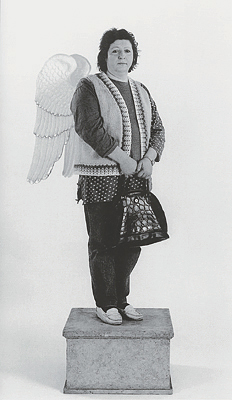| Revista Umělec 1998/1 >> Fotofest | Lista de todas las ediciones | ||||||||||||
|
|||||||||||||
FotofestRevista Umělec 1998/101.01.1998 Aleš Kuneš | exhibition | en cs |
|||||||||||||
|
At the beginning of last autumn, the city of Groningen, the Netherlands, opened a festival of photography, Noorderlicht. The festival has enough self-confidence in clearly declared opinion on contemporary photography to become one of the manifestos of the view of the world through this medium.
In contrast to a large number of photography festivals, dissolved in a number of expositions, the curators of this festival (Ton Broekhuis and Wim Melis) concentrated all their energy to three main projects, adding smaller one-man shows in galleries around town. The central topics prefer the necessity to touch on important areas of contemporary thought to subjective one-man exhibitions. This is also appearant in the 300-page catalogue in which the individual curators withdraw into short, modest yet thorough and to-the-point texts. The photographers are not set into image blocks, they rather make up images based on their mutual connection and gradation. Well-known artists appear in one line with much younger and almost unknown people. The Garden of Eden was the most extensive and central part of the exposition. By avoiding the word Paradise and choosing the originally Hebrew word Eden, the exhibition reflects Jewish and Christian tradition of the notion of paradise without sin and with direct relation to God. Genesis is only absolute comparison with atomicly spread out momentary joy of our lives. Only outside this paradise may a human being realize consciense. Particular cultural and social context is looked upon in topical stories of mostly narrative motives. The ideal place is more often replaced by separate space. Paradise is not reality but a segment of consciense. Individulalization is a phenomenon typical for the new age. Concepts of “paradise“ based on socialism or libertarianism (people under control - manipulation and control), “paradise of science and technology“ are just partial areas of the many illusions of the 20th century. All crimes of culture lead to “paradise“. Concentration camps, Auschwitz and Hiroshima - this all was leading to “humane paradise“. The ability to communicate or an extreme personal experience, an intellectual or emotional touch of our nostalgia for paradise. A sin is without a doubt always punished and coming back to paradise is nowadays a sin first of all. Or is it paradise when we forget ourselves? One has to watch out. Photographs of “eden“ are personal interpretations in many expressive variations among contexts of unusually different worlds. How much space can be found here for new billions of people. Borders between cultures are a manifesto of returns. Informative configurations of pictures all of a sudden appear in new, surprising units. The play of words Unbeschreiblich weiblich? of German punk singer Nina Hagen sets off the second part of the exhibition curated by Anne Karen de Boer. “Undescribable and feminine“, however, shows both female and male photographers. It deals with a lot of issues aimed against the stereotypes of culture and tradition, as well as the role of media in creating an image of a woman. The third project, The Chain, was a group show of photographers mutually linked by randomly composed chain throughout the world. It is the fourth or fifth event of this kind. It reminds of the Chinese whisper game or classic surrealist activities. Just as in Chinese whisper, the most important parts are the original impetus and the last part of the chain. Yet, it is interesting to follow the whole process of the transformation. The idea for such a project was first presented in USVA Photo Gallery in Groningen in 1992. Right from the start, the point was not to present individual images or an exhibition of authors. A photographer receives a picture from a friend and immediately has to respond and send his or her piece to another friend in another country. Free associations of the photographers from different countries with different cultures and different typical mentality link to various photo styles of authors from various social groups, generations and different personal stories. The chain of images is then one image. In its ability to respond immediately, photograph is the ideal medium for this game.
01.01.1998
Artículos recomendados
|
|||||||||||||












Comentarios
Actualmente no hay comentariosAgregar nuevo comentario